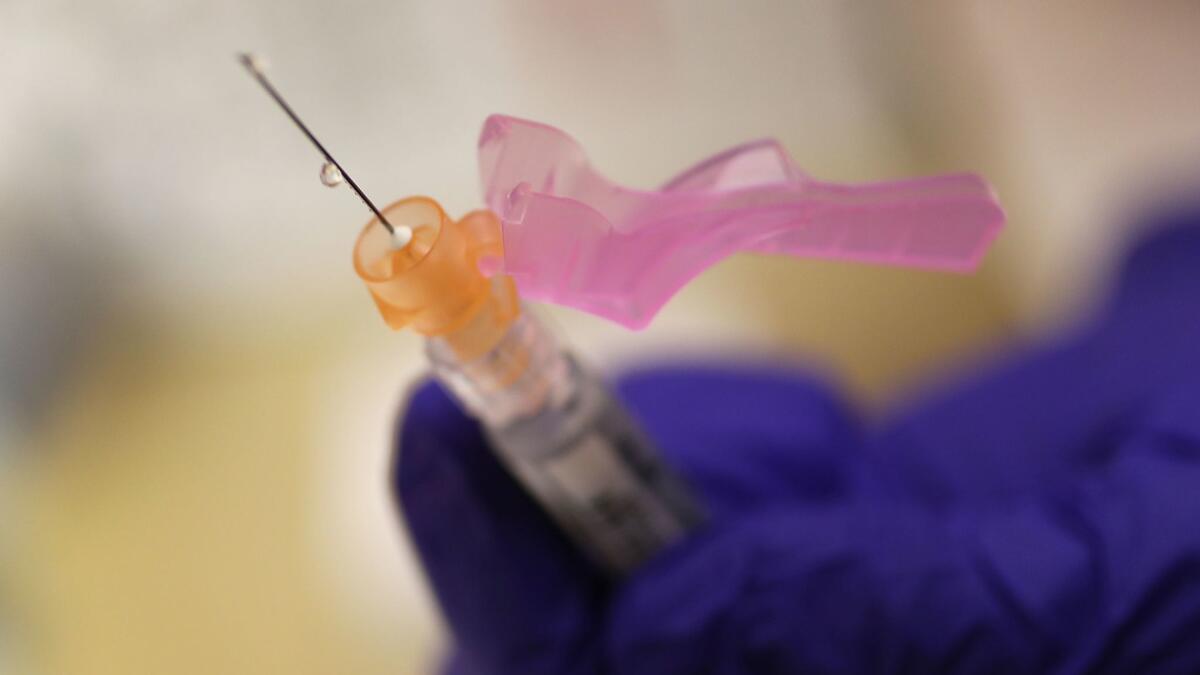Column: Medical exemptions threatening herd immunity

You know how cockroaches are notoriously hard to kill? That’s the way it is with the myths surrounding vaccinations.
Three years after California lawmakers passed Senate Bill 277, which requires every child enrolled in public school to be fully immunized against 10 diseases unless a doctor provides a medical reason for an exemption, the situation has improved.
By eliminating the so-called “personal belief exemption” that had previously allowed parents to send their unvaccinated kids to public school for virtually any reason, the immunization rate of kindergartners went from a dangerous 90.4% in the 2014-15 school year to 95.1% in 2017-18. This means that the overall rate in California has now reached the level at which a population achieves “herd immunity” that protects against outbreaks of disease.
In other words, a lot of cockroaches have met their demise.
With apologies to the cockroaches — they are, after all, just doing their thing, trying to survive — that is good news. But the positive movement is shaded by the darker reality that in some communities, and in small pockets within those communities, immunization rates remain stubbornly, frustratingly below levels considered safe.
It’s particularly telling that the California Department of Public Health reported that the overall immunization rate of the last school year, though still high, was actually 0.4% lower than in the 2016-17 school year.
What’s more, the share of permanent medical exemptions rose from 0.5% to 0.7% from one school year to the last, and from 0.2% before SB 277. The proportion lacking immunizations for “other reasons” rose from 0.5% to 1.1%, with 0.8% reported as enrolled in independent study programs, the agency reported.
The rate of those overdue for required immunizations also rose last year, from 1.0% to 1.2%.
Those are a lot of numbers to throw out, so the picture can be confusing, and the changes can appear tiny. But the upshot of all of this data is that people are still squeezing through the loopholes in the law. And while that is often justified — some children cannot be vaccinated for legitimate medical reasons — sometimes it’s not, and therein lies the problem.
In large measure, health officials believe, the loss of the personal belief exemption is being offset by an increase in medical exemptions, some of which are obtained under dubious circumstances.
According to a study conducted by University of Pennsylvania researchers in cooperation with California health officials, and published last month in the journal Pediatrics, bogus medical exemptions are on the rise.
The researchers found that some medical exemptions were given for reasons that are considered invalid, or they were signed by medical practitioners not authorized to provide exemptions. In one particularly egregious case, a doctor charged patients to watch a video in exchange for signing exemptions. Some doctors were identified who actually advertised their willingness to sign off on exemptions for a fee.
The study found other problems, including the fact that schools, not health officials, are responsible for deciding whether to accept medical exemptions; and attempts to track exemptions have been met with open hostility, legal challenges, and even death threats.
Many health care officials are calling for a crackdown on providers known to flaunt the limits and true intent of medical exemptions.
That could certainly help, but it won’t be enough. Keep in mind that the data cited above is for public school students. Many kids attend private schools, or are homeschooled, and they are not covered under SB 277. It’s likely that vaccination requirements are among the reasons some parents opt to keep their children out of public schools.
I believe that the only way to kill this cockroach for good is through strong, continued doses of education.
Parents’ suspicions about the safety of vaccinations have been fed by conspiracy theorists and medical crackpots whose harmful ideas, widely disseminated on the Internet, have been thoroughly debunked in every reputable corner of the medical establishment. Yet the rumors and myths persist, so we must continue to fight back with rationale, fact-based information campaigns and personal outreach to those who remain skeptical.
We must remind the doubters that vaccinations are one of the greatest public health achievements in modern history, right up there with antibiotics, seat belts and clean drinking water. They help prevent terrible diseases that once claimed thousands of lives every year, and they continue to protect those who are sick and unable to be vaccinated.
The 2014-15 measles outbreak traced to Disneyland that infected at least 147 people should have been enough to convince those still in denial about how easily diseases once thought conquered can resurface when vaccination rates fall. It was that outbreak that prompted state legislators to pass SB 277.
Even with that law now established, we see how fragile remains the effort to keep herd immunity intact. A raging measles outbreak in Europe this year has generated little attention here, even as health officials warn that something similar could easily occur in the United States if immunization levels drop.
That’s why we must continue to battle against the misinformation that plays on parents’ fears. It’s a tough bug to beat, but let’s hope we can do so before we experience a large-scale resurgence of deadly diseases.
Patrice Apodaca is a former Newport-Mesa public school parent and former Los Angeles Times staff writer. She lives in Newport Beach.
All the latest on Orange County from Orange County.
Get our free TimesOC newsletter.
You may occasionally receive promotional content from the Daily Pilot.




